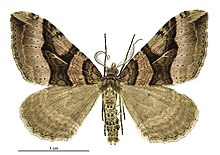| Xanthorhoe semifissata | |
|---|---|

| |
| Female | |

| |
| Male | |
| Scientific classification | |
| Domain: | Eukaryota |
| Kingdom: | Animalia |
| Phylum: | Arthropoda |
| Class: | Insecta |
| Order: | Lepidoptera |
| Family: | Geometridae |
| Genus: | Xanthorhoe |
| Species: | X. semifissata |
| Binomial name | |
| Xanthorhoe semifissata (Walker, 1862) | |
| Synonyms | |
| |
Xanthorhoe semifissata, commonly known as the barred pink looper. is a moth of the family Geometridae. It is endemic to New Zealand and is found throughout the country although it is much less common in the mountains in the south and west of the South Island. The larvae host plants include Nasturtium officinale as well as species in the Cardamine genus. Adult moths inhabit shrubs at the edge of native forest.
Taxonomy
This species was first described by Francis Walker in 1862 using specimens collected in Nelson by T. R. Oxley and named Cohemia semifissata. In 1939 Louis Beethoven Prout placed this species in the genus Larentia. In 1971 J. S. Dugdale placed this species in the genus Helastia. The genus Helastia was restricted by Craw in 1987 placing this species into the genus Xanthorhoe. This placement was accepted in 1988 by Dugdale. The lectotype specimen is held at the Natural History Museum, London.
Description

George Hudson described this species in 1898 as follows:
The expansion of the wings is about an inch. The fore-wings of the male are pale pink; there are several wavy brown lines near the base, a very distinct brown central band, narrowest near the middle, but much broader on the costa than on the dorsum; the centre of this band is paler towards the costa; the termen is shaded with brown, except near the apex of the wing; the veins are dotted in black. The hind-wings are bright ochreous with numerous wavy darker lines. The female is darker in colour than the male, the central band is broader; there are numerous brown and pink wavy lines on each side of the central band, and the principal veins are marked in pale ochreous. The grey transverse lines on the hind-wings are much more distinct in the female than in the male.
Distribution and habitat
This species is found in the North and South Islands of New Zealand as well as on Stewart Island. However this species is not common in the south and west mountains of the South Island. X. semifissata has been collected in Riccarton Bush, Christchurch.
The preferred habitat of this species is edge of forests. The hosts for the larvae of this moth are herbaceous plants. Gaskin noted eggs are laid on watercress (Nasturtium officinale). White listed Cardamine and stream Nasturtium as known larval foods.
Life cycle
Eggs
Eggs are pale green and hemispherical in shape.
Larva

The caterpillar is dark brown on its upper side and light brown below, When fully grown it is approximately 2.5 cm long.
Pupa
This species pupates in the leaf litter under the host plant.
Adult
Gaskin hypothesised that this species has two broods, the first in spring and early summer and the second in late summer. It is possible that the second may overwinter. The adults have been collected in March, May, August and October in Riccarton Bush, Christchurch. In the montane grasslands at Arthur's Pass, this moth was seen from November through to April.
References
- ^ R. C. Craw (April 1987). "Revision of the genus Helastia sensu stricto with description of a new genus (Lepidoptera: Geometridae: Larentiinae)". New Zealand Journal of Zoology. 14 (2): 269–293. doi:10.1080/03014223.1987.10422997. ISSN 0301-4223. Wikidata Q54670161.
- ^ Dugdale , J. S. (23 September 1988). "Lepidoptera - annotated catalogue, and keys to family-group taxa". Fauna of New Zealand. 14. Department of Scientific and Industrial Research: 1–264. doi:10.7931/J2/FNZ.14. ISSN 0111-5383. Wikidata Q45083134.
- Walker, Francis (1862). "XXV: Geometrites (continued)". List of the Specimens of Lepidopterous Insects in the Collection of the British Museum. pt. 25: 1281–1477 – via Biodiversity Heritage Library.
- Prout, L. B. (1939). "Geometridae: Fauna Indo-Australica". The Macrolepidoptera of the World. 12: 264 – via Biodiversity Heritage Library.
- Dugdale, J. S. (10 November 1971). "Entomology of the Aucklands and other islands south of New Zealand: Lepidoptera, excluding non-crambine Pyralidae". Pacific Insects Monographs. 27: 55–172. ISSN 0078-7515. Wikidata Q64006453.
- ^ George Vernon Hudson (1898), New Zealand moths and butterflies (Macro-lepidoptera), Illustrator: George Hudson, London, p. 59, doi:10.5962/BHL.TITLE.7912, OCLC 980865393, Wikidata Q19073637
{{citation}}: CS1 maint: location missing publisher (link) - White, E G (2002). New Zealand Tussock Grassland Moths. Lincoln, New Zealand: Manaaki Whenua Press. p. 291.
- Brian H. Patrick (1997). "Codfish Island moths" (PDF). The Wētā. 20: 17–20. ISSN 0111-7696. Wikidata Q110875754. Archived from the original (PDF) on 18 October 2008.
- ^ Gaskin, D E (1966). The Butterflies and Common Moths of New Zealand. Christchurch: Whitcombe and Tombs Limited. p. 134.
- ^ Molloy, Brian (1995). Riccarton Bush: Putaringamotu. Christchurch: The Riccarton Bush Trust. p. 227.
- ^ White, E G (1991). "The changing abundance of moths in a tussock grassland, 1962–1989, and 50- to 70- year trends". New Zealand Journal of Ecology. 15 (1): 5–22.
| Taxon identifiers | |
|---|---|
| Xanthorhoe semifissata | |